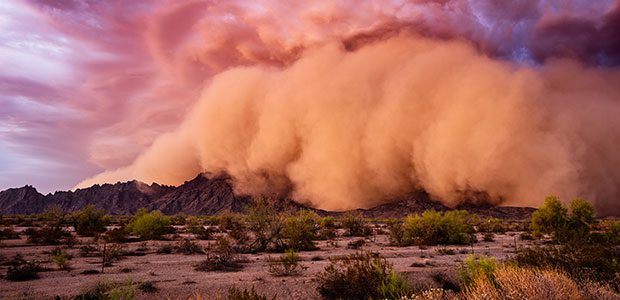Monsoon Season Maintenance
These tips for preparing your home for monsoon season will help make sure you are prepared early this year.
Those of us who are natives or have transplanted here over the years know all too well what the summer has in store, high temps, long days, and of course monsoon season. However, Arizona is a fast-growing state and population growth breaks down to roughly 200 new people moving into Phoenix daily. If you’re new to the state, you may be wondering “What is monsoon season?”
The monsoon season lasts from roughly mid-June to mid to late September. Around this time of the year the wind shifts sending moist, tropical air towards the desert. When the tropical winds arrive, they cause heavy rainfall and thunderstorms. Arizona gets between 40-50% of its annual precipitation during the monsoon season. Heavy rains on dry, parched land can lead to flash floods, dust storms, and winds strong enough to knock down trees. Arizona’s monsoon season can throw a lot at your home, so it is crucial to prepare it for this intense weather to avoid costly repairs. By following these steps, you can protect your home and property and enjoy a safe and comfortable monsoon season indoors.
Foundation, Windows, and Doors
Protecting your home’s foundation during monsoon season is crucial as water damage can cause significant issues both inside and outside of your home. To prevent such issues, make sure to check your gutters and downspouts to ensure they encourage proper runoff, and clear out any debris that may block them before the rains hit. If your backyard has drainage channels, don’t forget to clear them out as well to prevent water pooling.
Aside from checking your gutters and downspouts, it’s also important to seal any openings and cracks around the base of your home to prevent water from finding its way inside. You can use caulk to seal any cracks and consider proper weather stripping for your windows and doors to prevent heavy winds from pushing water in. You may also want to consider gap or joint filler around your home’s foundation to prevent mold and mildew issues. By taking these preventative measures, you can protect your home’s foundation.
Roofing
Don’t be afraid to reach out to a licensed roofing professional to examine your roof for any loose roof tiles or leaks, and don’t wait to have them fixed. Depending on how old your roofing underlayment is it may be time to replace that as well. They can also identify areas where water could build up and breach the home. The cost of roof work now is a lot less than roof work and replacing your ceiling, dry wall, and or flooring inside the house. If you need to replace any roof tiles or the underlayment, be sure to submit an architectural request to the Design Review Committee prior to scheduled maintenance, or after the fact on a post-submission basis for emergency repairs.
AC Units
The first thing you should do is ensure that there is clearance around your AC unit. Clear at least three to four feet around your AC unit(s) to prevent debris such as tree branches, dry leaves, or trash from getting into your AC unit during the intense monsoon winds. It is also recommended to check and change your AC filter before and after a big storm to ensure that it is clean and still effective. Monsoons move a lot of dirt, and a clean filter is important in maintaining indoor air quality and reducing energy bills.
Be sure to schedule your annual AC maintenance before monsoon season to check your system’s functionality, safety, and efficiency and to clean essential elements to prepare it for the upcoming intense weather. Another step you can take is to have your air ducts cleaned and sealed to remove dirt, pollen, and debris and protect your indoor air quality and energy bills. Proper preparation can help prevent costly AC repair bills and maintain your AC unit’s efficiency and lifespan.
Pergolas, Patio Furniture, and Proper Anchoring
With winds that can be in excess if 60 mph, monsoon winds mean serious business. Make sure you check all awnings, canopies, and shades to ensure they are tightly fastened. Inspect all pergolas, gazebos, and patio roof extensions for loose joints and footings. Stake down any lighter patio furniture, particularly tables and chairs, and be sure that umbrellas can be closed and stored securely before storms hit. These steps can prevent costly repairs and your neighbors from ending up with new patio furniture.
[Sidebar]
[Title]
After The Dust Settles
[Body]
Landscaping
Sometimes no matter how prepared you are disaster can strike. Following monsoon season, we see a sharp rise in the need for front yard tree replacements to meet the minimum landscaping requirements, as well as other dead landscaping that requires replacement. Another issue that often arises that is not covered in previous paragraphs is granite replenishment. Heavy rains can and will wash away dirt and granite. It is important to make sure that your front yard granite covers your entire yard at a depth of roughly two inches. If you need to replenish your front yard granite or replace a tree or other landscaping be sure to submit to and receive approval from the Design Review Committee before commencing any landscaping projects.
Paint and Stucco
The two best times of year to paint in Arizona are in the Spring and in the Fall. Coming out of monsoon season you may find new cracks in the stucco or areas where your paint is peeling or chipping. As a reminder, repainting (even the same color scheme) and stucco repairs are both maintenance items that require Design Review Committee approval. You don’t want to use the wrong color and have to repaint the entire home. It is important to verify color scheme options with the management team before you submit and receive approval prior to painting. Remember that when in doubt, give us a shout.








